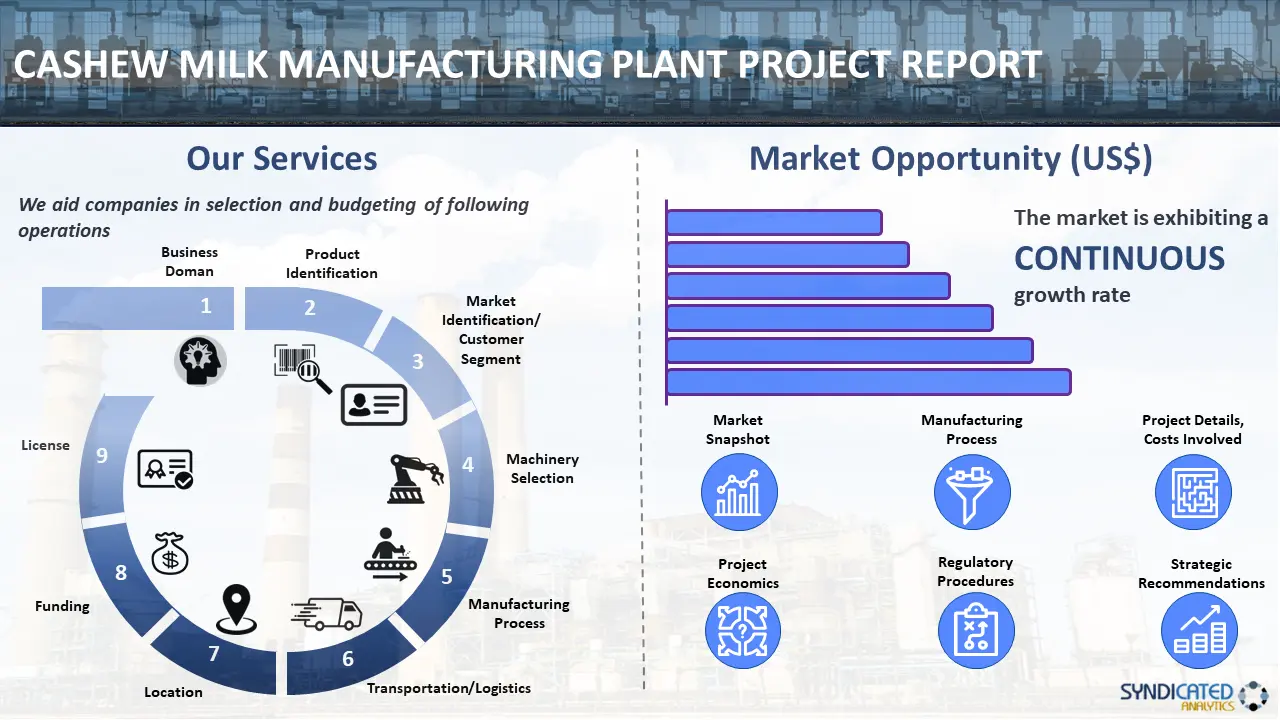
Cashew Milk Manufacturing Plant Project Report 2025 Edition
Report Coverage: Industry Analysis (Market Performance, Segments, Price Analysis, Outlook), Detailed Process Flow (Product Overview, Unit Operations, Raw Materials, Quality Assurance), Requirements and Cost (Machinery, Raw Materials, Packaging, Transportation, Utility, Human Resource), Project Economics (Capital Investments, Operating Costs, Profit Projections, Financial Analysis, Revenue), and Investment Opportunities
Report Overview:
The new report conducted by Syndicated Analytics, titled "Cashew Milk Manufacturing Plant Project Report 2025 Edition: Industry Analysis (Market Performance, Segments, Price Analysis, Outlook), Detailed Process Flow (Product Overview, Unit Operations, Raw Materials, Quality Assurance), Requirements and Cost (Machinery, Raw Materials, Packaging, Transportation, Utility, Human Resource), Project Economics (Capital Investments, Operating Costs, Profit Projections, Financial Analysis, Revenue), and Investment Opportunities," offers a comprehensive guide for establishing a manufacturing plant in the cashew milk industry. It encompasses a wide-ranging market overview and delves into specific details such as unit operations, raw material requirements, utility needs, infrastructure prerequisites, machinery and technology specifications, workforce demands, packaging prerequisites, transportation logistics, and more.
Furthermore, this report delivers extensive insights into project economics, including capital investments, project financing, operating costs, income and expenditure forecasts, fixed versus variable expenses, direct and indirect outlays, expected return on investment (ROI), net present value (NPV), profit and loss analysis, and comprehensive financial assessment.

Market Analysis
| Current Demand for Cashew Milk | The report evaluates the existing global demand for cashew milk. |
| Growth Prospects and Trends | The study delves into the growth prospects and emerging trends within the cashew milk market, providing insights to guide strategic decision-making. |
| Leading Segment and Regional Analysis | This study presents a concise overview of the key segments and regional influence in the cashew milk market, providing a comprehensive view of the industry's overall landscape. |
| Competitive Landscape | An analysis of the competitive landscape highlights key players in the cashew milk manufacturing industry, shedding light on their strategies and market positioning. |
A. Introduction
Cashew milk is a non-dairy and plant-based beverage obtained from processing cashews and water. It also incorporates other steps, such as soaking, drying, washing, extraction, sieving, filtration, cooling, and storage. Cashew milk is rich in vitamins, proteins, minerals, carbohydrates, magnesium, phosphorus, iron, potassium, zinc, and healthy fats, which assist in regulating blood sugar levels, boosting immunity, preventing the onset of cancer, and enhancing heart health. It has a creamy, rich consistency and is available in flavored and plain variants. As a result, it is widely used in coffee, hot chocolate, tea, sauces, ice cream, and other beverages to add texture and flavor. Currently, cashew milk is commercially available in various packaging solutions, such as cartons, pouches and bottles.
B. Market Trends/Drivers
The global cashew milk market is primarily being driven by the rising health consciousness among the masses. Cashew milk is widely used as an alternative source of milk and its byproducts due to its nutritional properties, such as high protein and vitamin contents. In line with this, the widespread product adoption due to the rising incidences of high cholesterol and vitamin B2 and B12 deficiencies is facilitating the demand for low-fat dairy products, such as cashew milk, which is supporting the market growth. Apart from this, various product innovations, such as the introduction of organic and unsweetened cashew milk that is gluten-free, vegan, eco-friendly, and low in calorie due to the increasing prevalence of celiac diseases, diabetes, and other food allergies, are providing an impetus to the market growth. Other factors, including the increasing demand for plant-based products, rising environmental concerns, rapid expansion in the food processing industry, and continuous advancements in manufacturing technologies to enable the mass production of the product, are anticipated to drive the market further toward growth.
The report provides a techno-commercial roadmap for setting up a cashew milk manufacturing plant. The study covers all the requisite aspects that one needs to know while making a foray into the cashew milk industry. This ranges from macro overview of the market to micro details of the industry performance, key success and risk factors, manufacturing requirements, project cost, project economics, expected returns on investment, profit margins, etc. This report is a must-read for entrepreneurs, investors, researchers, consultants, business strategists, and all those who have any kind of stake in the cashew milk industry.
Market Coverage:
| Current Demand for Cashew Milk | The report evaluates the existing global demand for cashew milk. |
| Growth Prospects and Trends | The study delves into the growth prospects and emerging trends within the cashew milk market, providing insights to guide strategic decision-making. |
| Leading Segment and Regional Analysis | This study presents a concise overview of the key segments and regional influence in the cashew milk market, providing a comprehensive view of the industry's overall landscape. |
| Competitive Landscape | An analysis of the competitive landscape highlights key players in the cashew milk manufacturing industry, shedding light on their strategies and market positioning. |
Project Feasibility
| Technical Feasibility | The study outlines the intricacies of cashew milk manufacturing, outlining the necessary equipment and technological requirements. A clear description of the manufacturing process is provided. |
| Financial Feasibility | The report presents an in-depth financial analysis, including the initial investment required, income and profit projections. These financial insights aim to assist potential investors in assessing the viability of the project. |
| Environmental and Regulatory Considerations | The report also discusses the environmental and regulatory aspects associated with cashew milk production, ensuring that the project aligns with sustainability and compliance standards. |
Project Implementation
| Location Selection | Choosing the optimal location for the manufacturing plant is crucial. This section explores location-based factors impacting the project's success. |
| Plant Design and Layout | Detailed plant design and layout plans are presented, emphasizing efficient production processes and workspace ergonomics. |
| Procurement of Raw Materials | An overview of the procurement process for raw materials necessary for cashew milk production is provided, ensuring a smooth supply chain. |
| Production Process | An explanation of the cashew milk production process is provided in the study, from raw material input to the final product, highlighting key stages and quality control measures. |
| Quality Control Measures | Stringent quality control measures are outlined to ensure the production of high-quality cashew milk. |
Risk Analysis
| Identification of Potential Risks | Potential risks associated with the project are identified, allowing for proactive risk management strategies. |
| Risk Mitigation Strategies | The report proposes risk mitigation strategies to minimize the impact of identified risks on the project's success. |
Seeking a Tailored Project Report?
While we have endeavored to create a comprehensive report, we acknowledge that each stakeholder may possess unique requirements. In light of this, we offer the option to customize the report to align with your specific needs. You can convey your business specifications to our consultants, and we will furnish you with a personalized scope tailored precisely to your requirements. Some of the common customizations that our clients often request include:
- Tailoring the report to suit the country/region where you intend to establish your plant.
- Adapting the manufacturing capacity of the plant to meet your specific needs.
- Customizing machinery suppliers and costs to align with your requirements.
- Incorporating any additional elements into the existing scope as per your specifications.
Report Scope:
| Features | Details |
|---|---|
| Currency | US$ (Information can also be provided in the local currency) |
| Pricing and Purchase Options | Single User License: US$ 3450 Five User License: US$ 4450 Corporate User License: US$ 5450 |
| Customization Scope | The report can also be customized based on the requirements of the customer. |
| Post-Sale Analyst Support | 12-14 Weeks |
| Delivery Format | PDF and Excel through email (We can also provide the editable version of the report in PPT/Word format on special request) |
Questions Addressed in the Report:
- What has been the performance of the cashew milk market to date, and what are the projections for its future growth?
- How is the cashew milk market segmented globally?
- How is the cashew milk market distributed across various regions?
- What trends are observed in the pricing of different feedstocks within the cashew milk industry?
- What constitutes the structure of the cashew milk industry, and who are its major stakeholders?
- What key operations are necessary for manufacturing cashew milk?
- How much land is required to establish a cashew milk manufacturing plant?
- What is the planned layout for a cashew milk manufacturing plant?
- What equipment is essential for starting a cashew milk manufacturing plant?
- What materials are needed to begin production in a cashew milk manufacturing plant?
- What are the packaging necessities for a cashew milk manufacturing plant?
- What transportation logistics are required for a cashew milk manufacturing plant?
- What utilities are needed to operate a cashew milk manufacturing plant?
- What staffing is necessary for the operation of a cashew milk manufacturing plant?
- What are the estimated infrastructure costs for establishing a cashew milk manufacturing plant?
- What initial investments are necessary for setting up a cashew milk manufacturing plant?
- What will the ongoing operational expenses be for a cashew milk manufacturing plant?
- How should be the pricing structure for the final product in the cashew milk industry?
- What are the expected revenues and costs associated with running a cashew milk manufacturing plant?
- How long will it take for the plant to reach the break-even point?
- What are the forecasted profits from establishing a cashew milk manufacturing plant?
- What factors determine success and what risks exist in the cashew milk industry?
- What regulations must be complied with to establish a cashew milk manufacturing plant?
- What certifications are necessary to operate a cashew milk manufacturing plant?
Why Choose Syndicated Analytics:
- Our reports offer valuable insights to stakeholders, enabling them to make informed business decisions confidently.
- We maintain a robust network of consultants and domain experts spanning over 100 countries across North America, Europe, Asia Pacific, South America, Africa, and the Middle East.
- Our extensive database includes equipment, and raw material suppliers from major continents, ensuring comprehensive coverage.
- We diligently track and update critical factors such as land costs, raw material costs, construction costs, utility expenses, labor costs, and more, across more than 100 countries worldwide.
- Syndicated Analytics is the trusted partner of choice for leading corporations, governments, and institutions globally. Our clientele ranges from small startups to Fortune 500 companies.
- Our dedicated in-house team comprises experts in various fields, including engineers, statisticians, modeling specialists, chartered accountants, architects, and more. They play a pivotal role in developing, expanding, and optimizing sustainable manufacturing facilities worldwide.
Purchase Options
Ask For Customization
Personalize this research
Triangulate with your own data
Get data as per your format and definition
Gain a deeper dive on a specific application, geography, customer or competitor
Any level of personalization
Get in Touch
Call us on
US: +1-213-316-7435
Uk: +44-20-8040-3201
Drop us an email at
sales@syndicatedanalytics.com